AMD Radeon HD 7870 GHz Edition & Radeon HD 7850 Review: Rounding Out Southern Islands
by Ryan Smith on March 5, 2012 12:01 AM ESTCrysis: Warhead
Kicking things off as always is Crysis: Warhead. It’s no longer the toughest game in our benchmark suite, but it’s still a technically complex game that has proven to be a very consistent benchmark. Thus even four years since the release of the original Crysis, “but can it run Crysis?” is still an important question, and the answer continues to be “no.” While we’re closer than ever, full Enthusiast settings at a 60fps is still beyond the grasp of a single-GPU card.
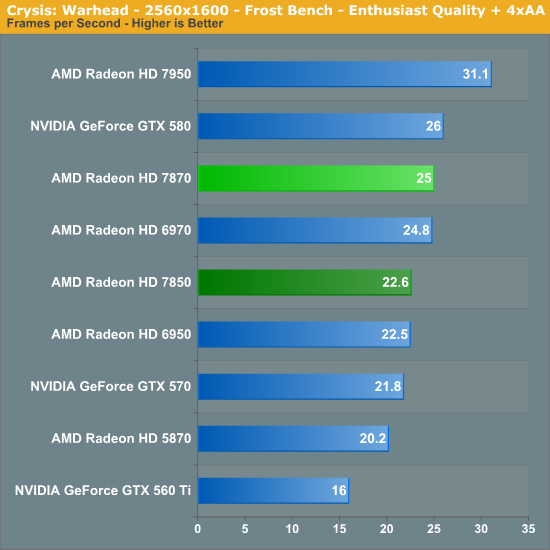
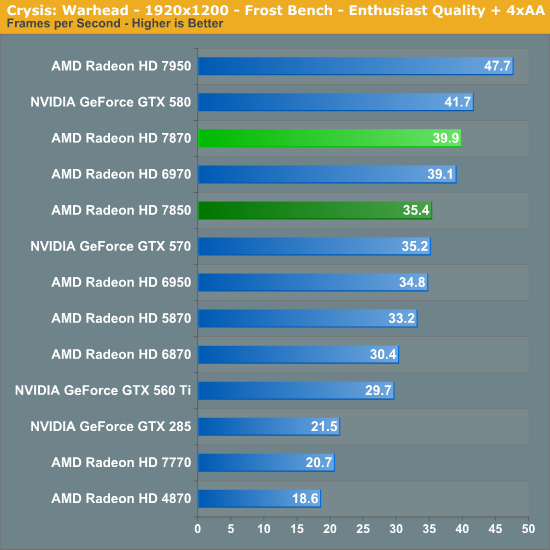
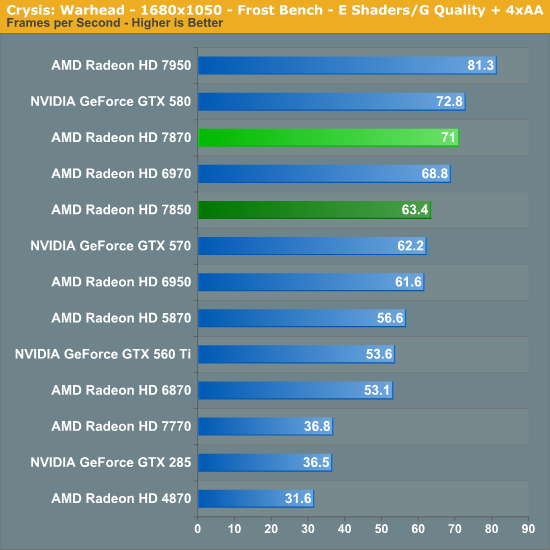
As we’ll see throughout today’s benchmarks, Crysis ends up being a good proxy for the 7800 series’ performance, especially compared to the outgoing 6900 series. Ahead of the Southern Islands launch there was some doubt that AMD could deliver 6900 series performance with the 7800 series, and this doubt increased after the 7700 series underperformed the 6800 series. Results like what we're seeing with Crysis should make it clear that the 7800 series is more than a competitor for the 6900 series, with both the 7870 and 7850 equaling or beating the 6970 and 6950 respectively in almost all tests.
Overall at 1920x1200 the 7870 gets 39.9fps, which isn’t quite enough to smoothly handle enthusiast quality and 4x MSAA. Meanwhile the 7850 is farther down the line at 35.4fps; both cards would need Crysis’s settings turned down to reach 60fps here. Compared to the 7950 the 7870 trails it by 17%, giving AMD’s next card up a fairly wide lead in this game.
Meanwhile compared to NVIDIA’s lineup the 7800 series does quite well here, reflecting the fact that the 7800 series doesn’t have a true equal in NVIDIA’s existing lineup. At 1920 the 7870 leads the GTX 570 by 12% and is within spitting distance of the GTX 580, while the 7850 is virtually tied with the more expensive GTX 570 while it leads the GTX 560 Ti by 19%. Elsewhere at 2560 the 7870 has a similar lead, while the 7850 has a 41% lead on the GTX 560 Ti; while 2560 is not the ideal resolution for either card, it’s something to keep in mind when we begin discussing the impacts of the 7800’s 2GB of RAM.
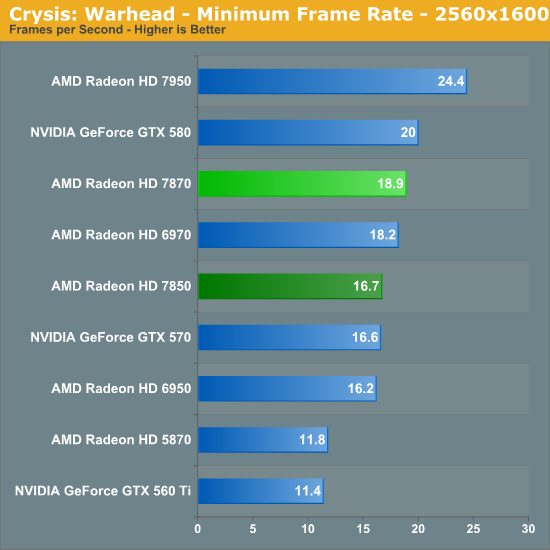
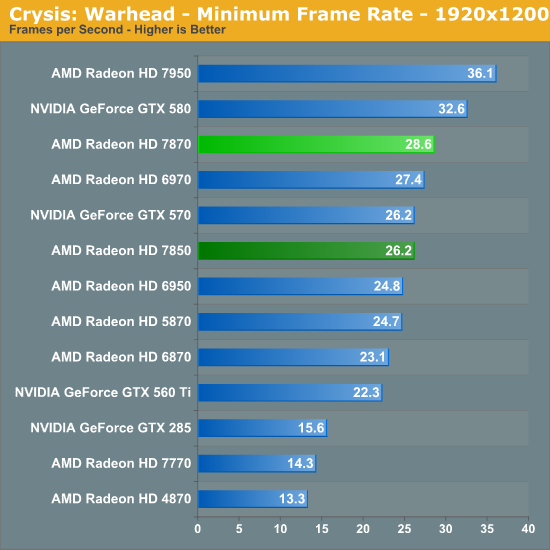
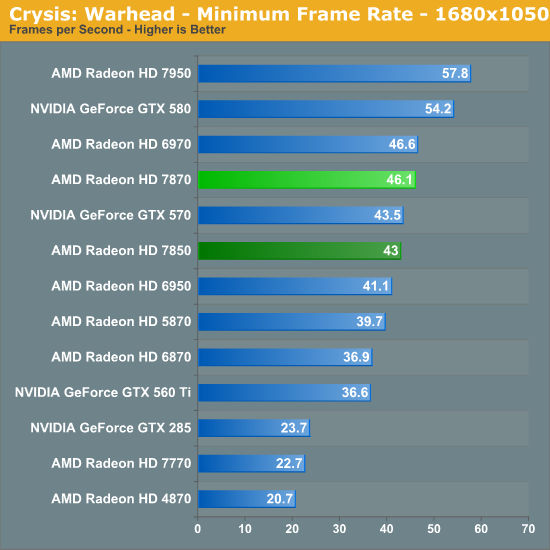
When it comes to minimum framerates in Crysis the relative rankings are nearly identical. The 7800 series extends their lead over the 6900 series by a slight degree, while the lead over NVIDIA’s cards shrinks slightly.










173 Comments
View All Comments
fingerbob69 - Tuesday, March 6, 2012 - link
It ain't, the 7870 is faster by 25-33% depending on the res. Price wise it's about 30% more (UK) but that fits with the bump in performance. So, you're wrong.Houdani - Monday, March 5, 2012 - link
Hey! My mom was born on Pitcairn. It's the top of a blown off volcano, only 1x2 miles large. No correlation, I'm sure. Interesting.AlB80 - Monday, March 5, 2012 - link
It beats 6950. 6970 and 7850. Is it correct?haukionkannel - Monday, March 5, 2012 - link
Well these are good card even at this moment! Ofcource we can hope cheaper prizes, but that need at least two competitors and at this moment there is none...And I would not wonder if Kepler will be prices accordingly. Those kepler chip are bigger, if leak are true, so they should be faster and they definitely will be more expensive (if not counting those renamed low end cards tha allso AMD is releasing this time)
AMD is not getting profit (in total) and Nvidia has a lot of new staff going on that need a lot of money to develop, so there seems to be zero reason to both company to reduce the prices... pity but true.
If you have good 5000 or 6000 series card you don't need these (same as if you have good 6600 serieas cpu you don't need ivy...) at this moment. But if you need a lot of power for little power usage these are extremely good and allso as someone said, these are very small chips! So there is a lot of room for a little bit bigger for 8000 series. Tick tock... Seems to be a lot like Intel Ivy vs Hasvell. Ivy does not offer a much compared to sandy, only smaller power usage and a little bit better speed. Like someone else said, very similar situation.
Hubb1e - Monday, March 5, 2012 - link
The upgrade from a 5800 to a 7800 may be only 20-40% on stock clocks, but add in the extra headroom the 7800 has when overclocking and you're looking at a decent upgrade. Once the prices come down on these I'm sure you'll see quite a few folks dropping their 5800 for a 7800.PurpleMoose - Monday, March 5, 2012 - link
The 7850 (usually) slightly outperforms the 6950 despite having only 1024 shaders compared to 1408, with a ~7% core overclock (and a slight memory underclock). Even being conservative, that would make the GCN shaders about a third more efficient than the VLIW4 ones. But if we assume that a VLIW4 cluster performs more or less the same as a VLIW5 cluster, as does seem to be the case, then we can compare a hypothetical VLIW4-based 5770 with 640 shaders to the 7770. In this case the 7770 outperforms the 5770 basically by its clock speed difference, in other words clock for clock, shader for shader, VLIW4/5 vs GCN seems to be a wash.So why doesn't the 7700 series show as much (ie any) improvement?
The most obvious deficiency is the memory bus and memory bandwidth, but if thats the case why not add more? Alternatively, if you're happy with the performance as is, why not cut away a few more shader groups as it seems the card really can't use them, and save even more space? I had a very brief look for overclocked results and couldn't really find any - what I'd find really interesting is if anyone has benched a stock 7770 against a 7750 running at 7770 frequencies. I wonder how much the loss of shaders would hurt.
jesh462 - Monday, March 5, 2012 - link
Whenever I read an article on the new 7xxx series, I can't help but wonder if people remember what they're looking at. AMD moved to 28nm with this series. They also introduced a completely new architecture. They did so with no complications and without going overtime on the release date.This hasn't been done before. Even Intel doesn't attempt to do this with their CPUs. Tick, then tock, right?
Not only did AMD manage to get their new line up out, but the new cards have performance that exceeds their Nvidia counterparts on both the gaming and compute levels, in most cases. People who buy actual retail samples of the 7xxx series are pleased with the great overclocking headroom. It's obvious that there is a lot of room, even in the 7xxx series current iteration, for growth.
Despite all this, I still see people talk about how a 7xxx card isn't worth it, and how AMD is a sh*t company. Really? Ok.
Disclaimer, I own an i7 laptop with a geforce 560 blah blah.. fanboy whatever. Just think about this before you post. Yeah the new cards could use a price drop. We all know they will, sooner or later. That's why it's called the waiting game.
arjuna1 - Monday, March 5, 2012 - link
a 7xxx card is not worth it and AMD is not a sh*t company.I tend to agree with you for the most part but, there are no NVIDIA's counterparts for the 7xxx series, yet, and when there is, the 7xxx will go down in prices and then their value will increase.
CeriseCogburn - Thursday, March 8, 2012 - link
I'm sorry, we were promised southern islands for the 6000 series, and then, all that changed...What we really have here is a release that is like 2 years late.
Apparently once AMD re-announces it's new release schedule after admitting it missed it's last release target... all you people suddenly get a gigantic case of perfect amnesia.
To put it simply this is AN ENTIRE GENERATION LATE ON THE PROMISED RELEASE.
mattgmann - Monday, March 5, 2012 - link
Where is this misconception that the pricing is anywhere near acceptable on these new parts coming from? So they fit right in with the current price/performance ration. So what? AMD has basically put out a new line of cards that match their competitors previous generation and cost SLIGHTLY less.Aren't technologies supposed to get better? What's the point in upgrading if you get basically the same amount of performance for your dollar today as when you bought you last part?
Intel's new top end processors cost the same as last generation's, and the generation before that. New products replace old ones in pricing structures. AMD is raking in cash on these cards. They're less expensive to produce than last generation and retail for MORE money.
AMD is taking full advantage of their current market position, and instead of passing on ANYTHING to the consumer, is milking every profitable drop.
These cards' performance is impressive when compared apples to apples against last generation's equivalents. But since they basically all occupy a price slot a full tier higher than their predecessors, the comparison is moot.
Too bad the only 2 companies in the graphics card race are so ill equipped to advance the industry. AMD, Nvidia, get a clue.